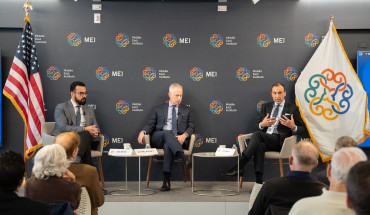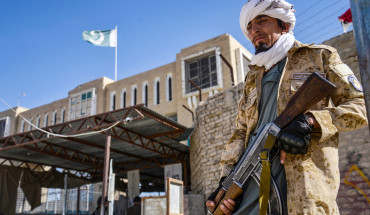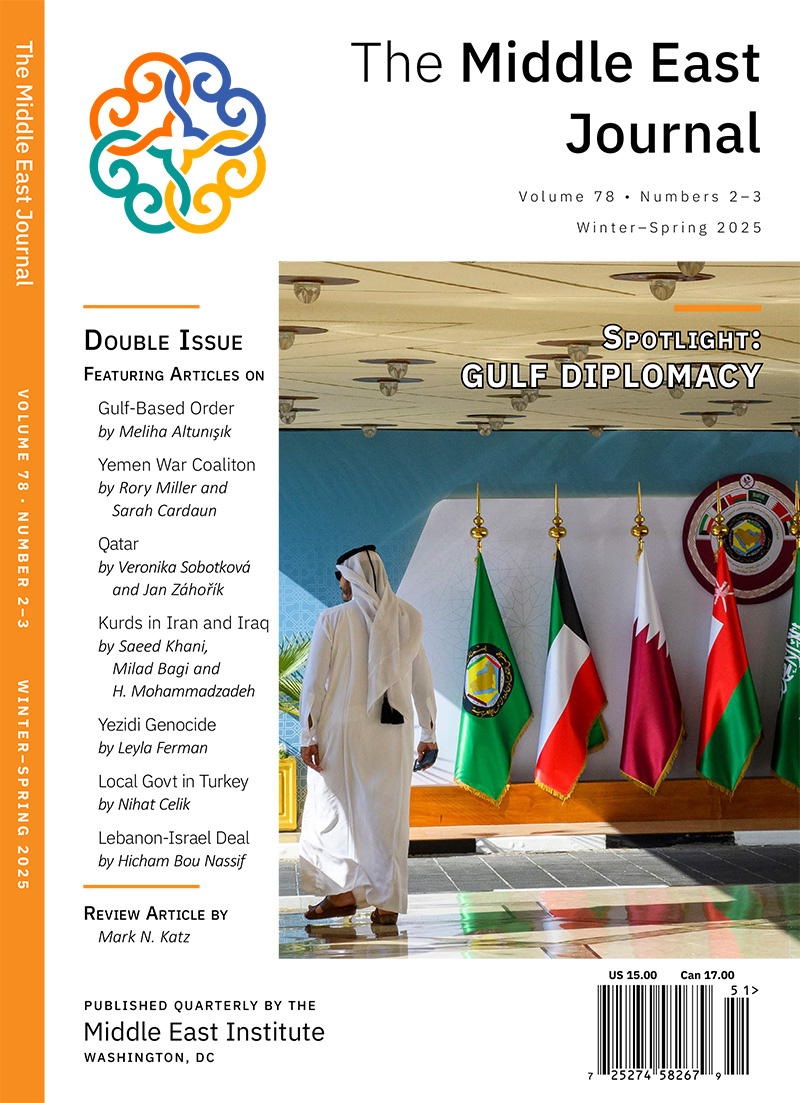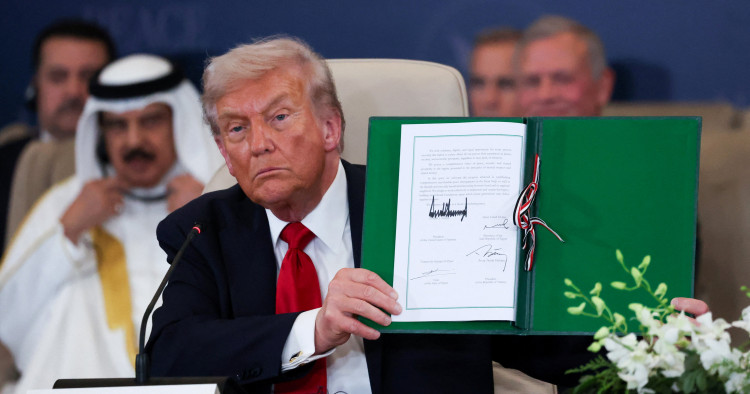US President Donald Trump started off his week by flying to Israel and Egypt to mark the Gaza cease-fire and release of the last remaining Israeli hostages. On this lightning visit, Trump did what he does best: he seized the spotlight at just the right time to dominate network coverage at the beginning of a crowded news cycle and basked in the achievement.
The cease-fire deal represents a significant, tangible foreign policy accomplishment early in Trump’s second term, although it is only the first phase in a presumably long process, with many implementation challenges yet to be resolved.
As these positive developments unfolded in the Middle East, the Trump administration’s overall agenda was weighed down on other fronts: a government shutdown in the United States entered its third week, and tensions on the US-China front spilled over into global markets and geopolitics, a reminder that the foundations of American policy remain uncertain on important strategic fronts.
Trump doubles down on the Middle East
The second Trump administration has invested more time and effort in the broader Middle East than any recent US administration has in its opening months, other than perhaps the first Obama administration in 2009. This is a reflection of how President Trump sees the promise and potential in a region that remains fraught with risk, notwithstanding possible silver linings looming over the horizon.
Trump 2.0’s Middle East record during its first six months in office was mixed and inconclusive on key strategic fronts like Iran and Israel-Palestine, which is what makes this Gaza cease-fire and the potential it holds for shifting negative regional trends in a different direction so important. The images of hundreds of thousands of Palestinians returning to their homes, most destroyed by two years of war, and living Israeli hostages receiving warm welcomes from their families were a key part of the storyline of this week. They offered a brief respite of hope after two dark years.
Many questions remain unanswered and details undefined about whether Hamas will disarm and give up control in Gaza and if regional countries will follow through on commitments to help secure the territory and rebuild. But that is the work of policymakers and analysts to sort through in the weeks and months ahead.
One important point about the second Trump administration’s foreign policy thus far that should not be ignored: President Trump has invested more time and energy in its opening months in efforts to reshape Arab-Israeli dynamics than any US president has done since at least the 1990s. His recent predecessors have tried to de-prioritize the conflict in America’s overall agenda, and they often found themselves in a reactive, crisis-management mode. Trump has the ego and ambition to think and speak big when it comes to the Middle East.
One concrete example of his personal commitment to the region is the fact that he made the trip to Israel and Egypt this week despite everything else that is percolating on America’s agenda.
Trump spent more time in Air Force One flying to and from the Middle East than he did on the ground — twice as much on travel (about 24 hours round trip) as on actual engagement (around 12 hours). And the bulk of his itinerary in the two countries was spent giving public speeches — at the Israeli Knesset and at a hastily organized summit in Sharm el-Sheikh in Egypt — underscoring that the focus was on photo-ops and strategic communications.
This is an important part of what leaders do, and the fact that Trump loves to keep the spotlight on himself is a potential advantage in shaping public perceptions when turbulence comes in later stages. One thing Trump understands is that shaping the narrative is a key part of his job, and he does this in his own unique way. Recall that during former President Joe Biden’s trip to Israel and Saudi Arabia in 2022, there were some public engagements combined with significant work behind the scenes. Biden delivered a major speech about US engagement in the Middle East that made a lot of important commitments, but it was done on a Saturday, when few Americans were paying much attention.
This marks an important difference between Trump 2.0 and his predecessor when it comes to crafting a proactive approach to the Middle East: Trump has made it clear that the region is a higher priority than the Biden team did. It will take more than strategic communications and optics to achieve progress beyond this current Gaza cease-fire — given Trump’s track record on other foreign policy issues, it is in the policy implementation and follow through where things are likely to fall apart. But the fact that Trump is inclined to spend as much time and energy on relationships in the Middle East as he has is one of the things that makes him distinctive.
With Saudi Crown Prince Mohammad bin Salman planning to visit Washington, DC, in November, the Middle East is likely to remain front and center in Trump’s overall policy agenda.
Trump’s stagnating domestic standing amid persistent challenges at home and abroad
It is too soon to determine whether Trump received a significant political boost from his Middle East visit — time and forthcoming opinion polls will tell. Some argue that helping end an unpopular war in Gaza will improve his standing, while other analysts assess that most Americans are not paying close attention to the Middle East as the most pressing issues are all closer to home. Only a small percentage of Americans — 6% — see all of the national security questions America faces (including China, Russia, terrorism, as well as Middle East issues) as a top priority, outpaced by inflation, jobs, health care, and immigration, among other concerns. Just before this major positive development in the Middle East, a strong majority of Americans polled disapproved of the job he is doing.
The biggest challenge on the agenda right now is the ongoing partial closure of the US government because of a protracted battle between Republicans and Democrats over domestic priorities like health care. The economic, institutional, and social services costs of this shutdown are starting to mount, and the Trump administration is trying to blame the Democrats for the standoff. At the same time, simmering tensions over Trump’s aggressive immigration policies, including the deployment of National Guard troops in large US cities, along with recent moves to prosecute public figures like former Federal Bureau of Investigation (FBI) Director James Comey, have all shifted America’s attention inward.
On the global stage, the biggest item on the agenda beyond the Middle East is the escalating tension between China and America over tariffs and economic relations, as both countries look to finalize a possible deal on these points of dispute. Another hot topic are the targeted strikes the US military is conducting against purported Venezuelan drug cartel boats, which have sparked a debate in Congress and the country at large about the legality of these actions. Trump simultaneously continues to seek a pathway to ending Russia’s war against Ukraine — an issue where the president readily admits he has not achieved what he had hoped.
Regardless, America’s attention will, for the foreseeable future, remain focused inward. Trump’s weak political position at home and the fact that he has not been able to keep the US government open even though his party controls the Executive Branch and both houses of Congress raises significant questions about whether he will be able to make additional progress in the Middle East. If Trump cannot bridge the serious divides between Republicans and Democrats, will he do it between Israelis and Palestinians?
The president’s impromptu trip shows he has the ambition and the energy to get big things done in the Middle East, but the question remains: do Trump and his team have the capacity and action plan to actually see things through until the end?
Brian Katulis is a Senior Fellow at the Middle East Institute.
Photo by Suzanne Plunkett - Pool / Getty Images
The Middle East Institute (MEI) is an independent, non-partisan, non-for-profit, educational organization. It does not engage in advocacy and its scholars’ opinions are their own. MEI welcomes financial donations, but retains sole editorial control over its work and its publications reflect only the authors’ views. For a listing of MEI donors, please click here.













